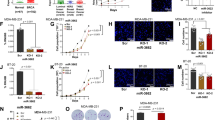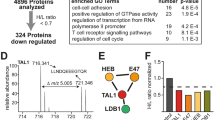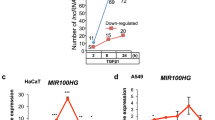Abstract
The microRNA-371-373 (miR-371-373) cluster is specifically expressed in human embryonic stem cells (ESCs) and is thought to be involved in stem cell maintenance. Recently, microRNAs (miRNAs) of this cluster were shown to be frequently upregulated in several human tumors. However, the regulatory mechanism for the involvement of the miR-371-373 cluster in human ESCs or cancer cells remains unclear. In this study, we explored the relationship between this miRNA cluster and the Wnt/β-catenin-signaling pathway, which has been shown to be involved in both stem cell maintenance and tumorigenesis. We show that miR-371-373 expression is induced by lithium chloride and is positively correlated with Wnt/β-catenin-signaling activity in several human cancer cell lines. Mechanistically, three TCF/LEF1-binding elements (TBEs) were identified in the promoter region and shown to be required for Wnt-dependent activation of miR-371-373. Interestingly, we also found that miR-372&373, in turn, activate Wnt/β-catenin signaling. In addition, four protein genes related to the Wnt/β-catenin-signaling pathway were identified as direct targets of miR-372&373, including Dickkopf-1 (DKK1), a well-known inhibitor of Wnt/β-catenin signaling. Using a lentiviral system, we showed that overexpression of miR-372 or miR-373 promotes cell growth and the invasive activity of tumor cells as knockdown of DKK1. Taken together, our study demonstrates a novel β-catenin/LEF1–miR-372&373–DKK1 regulatory feedback loop, which may have a critical role in regulating the activity of Wnt/β-catenin signaling in human cancer cells.
This is a preview of subscription content, access via your institution
Access options
Subscribe to this journal
Receive 50 print issues and online access
$259.00 per year
only $5.18 per issue
Buy this article
- Purchase on Springer Link
- Instant access to full article PDF
Prices may be subject to local taxes which are calculated during checkout






Similar content being viewed by others
References
Aguilera O, Fraga MF, Ballestar E, Paz MF, Herranz M, Espada J et al. (2006). Epigenetic inactivation of the Wnt antagonist DICKKOPF-1 (DKK-1) gene in human colorectal cancer. Oncogene 25: 4116–4121.
Avvisato CL, Yang X, Shah S, Hoxter B, Li W, Gaynor R et al. (2007). Mechanical force modulates global gene expression and beta-catenin signaling in colon cancer cells. J Cell Sci 120: 2672–2682.
Bandres E, Cubedo E, Agirre X, Malumbres R, Zarate R, Ramirez N et al. (2006). Identification by real-time PCR of 13 mature microRNAs differentially expressed in colorectal cancer and non-tumoral tissues. Mol Cancer 5: 29.
Bartel DP . (2004). MicroRNAs: genomics, biogenesis, mechanism, and function. Cell 116: 281–297.
Cairo S, Wang Y, de Reynies A, Duroure K, Dahan J, Redon MJ et al. (2010). Stem cell-like micro-RNA signature driven by Myc in aggressive liver cancer. Proc Natl Acad Sci USA 107: 20471–20476.
Clevers H . (2006). Wnt/beta-catenin signaling in development and disease. Cell 127: 469–480.
Dravid G, Ye Z, Hammond H, Chen G, Pyle A, Donovan P et al. (2005). Defining the role of Wnt/beta-catenin signaling in the survival, proliferation, and self-renewal of human embryonic stem cells. Stem Cells 23: 1489–1501.
Eulalio A, Huntzinger E, Izaurralde E . (2008). Getting to the root of miRNA-mediated gene silencing. Cell 132: 9–14.
Falk S, Wurdak H, Ittner LM, Ille F, Sumara G, Schmid MT et al. (2008). Brain area-specific effect of TGF-beta signaling on Wnt-dependent neural stem cell expansion. Cell Stem Cell 2: 472–483.
Giles RH, van Es JH, Clevers H . (2003). Caught up in a Wnt storm: Wnt signaling in cancer. Biochim Biophys Acta 1653: 1–24.
Gonzalez-Sancho JM, Aguilera O, Garcia JM, Pendas-Franco N, Pena C, Cal S et al. (2005). The Wnt antagonist DICKKOPF-1 gene is a downstream target of beta-catenin/TCF and is downregulated in human colon cancer. Oncogene 24: 1098–1103.
He TC, Sparks AB, Rago C, Hermeking H, Zawel L, da Costa LT et al. (1998). Identification of c-MYC as a target of the APC pathway. Science 281: 1509–1512.
Hirata H, Hinoda Y, Nakajima K, Kawamoto K, Kikuno N, Ueno K et al. (2011). Wnt antagonist DKK1 acts as a tumor suppressor gene that induces apoptosis and inhibits proliferation in human renal cell carcinoma. Int J Cancer 128: 1793–1803.
Houbaviy HB, Dennis L, Jaenisch R, Sharp PA . (2005). Characterization of a highly variable eutherian microRNA gene. RNA 11: 1245–1257.
Huang Q, Gumireddy K, Schrier M, le Sage C, Nagel R, Nair S et al. (2008). The microRNAs miR-373 and miR-520c promote tumour invasion and metastasis. Nat Cell Biol 10: 202–210.
Inui M, Martello G, Piccolo S . (2010). MicroRNA control of signal transduction. Nat Rev Mol Cell Biol 11: 252–263.
Judson RL, Babiarz JE, Venere M, Blelloch R . (2009). Embryonic stem cell-specific microRNAs promote induced pluripotency. Nat Biotechnol 27: 459–461.
Kapinas K, Kessler C, Ricks T, Gronowicz G, Delany AM . (2010). miR-29 modulates Wnt signaling in human osteoblasts through a positive feedback loop. J Biol Chem 285: 25221–25231.
Kennell JA, Gerin I, MacDougald OA, Cadigan KM . (2008). The microRNA miR-8 is a conserved negative regulator of Wnt signaling. Proc Natl Acad Sci USA 105: 15417–15422.
Klein PS, Melton DA . (1996). A molecular mechanism for the effect of lithium on development. Proc Natl Acad Sci USA 93: 8455–8459.
Lluis F, Pedone E, Pepe S, Cosma MP . (2008). Periodic activation of Wnt/beta-catenin signaling enhances somatic cell reprogramming mediated by cell fusion. Cell Stem Cell 3: 493–507.
Mann B, Gelos M, Siedow A, Hanski ML, Gratchev A, Ilyas M et al. (1999). Target genes of beta-catenin–T cell-factor/lymphoid-enhancer-factor signaling in human colorectal carcinomas. Proc Natl Acad Sci USA 96: 1603–1608.
Munoz NM, Upton M, Rojas A, Washington MK, Lin L, Chytil A et al. (2006). Transforming growth factor beta receptor type II inactivation induces the malignant transformation of intestinal neoplasms initiated by Apc mutation. Cancer Res 66: 9837–9844.
Nagel R, le Sage C, Diosdado B, van der Waal M, Oude Vrielink JA, Bolijn A et al. (2008). Regulation of the adenomatous polyposis coli gene by the miR-135 family in colorectal cancer. Cancer Res 68: 5795–5802.
Ng EK, Chong WW, Jin H, Lam EK, Shin VY, Yu J et al. (2009). Differential expression of microRNAs in plasma of patients with colorectal cancer: a potential marker for colorectal cancer screening. Gut 58: 1375–1381.
Niida A, Hiroko T, Kasai M, Furukawa Y, Nakamura Y, Suzuki Y et al. (2004). DKK1, a negative regulator of Wnt signaling, is a target of the beta-catenin/TCF pathway. Oncogene 23: 8520–8526.
O'Donnell KA, Wentzel EA, Zeller KI, Dang CV, Mendell JT . (2005). c-Myc-regulated microRNAs modulate E2F1 expression. Nature 435: 839–843.
Palmer RD, Murray MJ, Saini HK, van Dongen S, Abreu-Goodger C, Muralidhar B et al. (2010). Malignant germ cell tumors display common microRNA profiles resulting in global changes in expression of messenger RNA targets. Cancer Res 70: 2911–2923.
Reya T, Clevers H . (2005). Wnt signalling in stem cells and cancer. Nature 434: 843–850.
Reya T, Morrison SJ, Clarke MF, Weissman IL . (2001). Stem cells, cancer, and cancer stem cells. Nature 414: 105–111.
Rouault JP, Rimokh R, Tessa C, Paranhos G, Ffrench M, Duret L et al. (1992). BTG1, a member of a new family of antiproliferative genes. EMBO J 11: 1663–1670.
Sato H, Suzuki H, Toyota M, Nojima M, Maruyama R, Sasaki S et al. (2007). Frequent epigenetic inactivation of DICKKOPF family genes in human gastrointestinal tumors. Carcinogenesis 28: 2459–2466.
Shtutman M, Zhurinsky J, Simcha I, Albanese C, D'Amico M, Pestell R et al. (1999). The cyclin D1 gene is a target of the beta-catenin/LEF-1 pathway. Proc Natl Acad Sci USA 96: 5522–5527.
Silver SJ, Hagen JW, Okamura K, Perrimon N, Lai EC . (2007). Functional screening identifies miR-315 as a potent activator of Wingless signaling. Proc Natl Acad Sci USA 104: 18151–18156.
Suh MR, Lee Y, Kim JY, Kim SK, Moon SH, Lee JY et al. (2004). Human embryonic stem cells express a unique set of microRNAs. Dev Biol 270: 488–498.
Voorhoeve PM, le Sage C, Schrier M, Gillis AJ, Stoop H, Nagel R et al. (2006). A genetic screen implicates miRNA-372 and miRNA-373 as oncogenes in testicular germ cell tumors. Cell 124: 1169–1181.
Wang Y, Baskerville S, Shenoy A, Babiarz JE, Baehner L, Blelloch R . (2008). Embryonic stem cell-specific microRNAs regulate the G1–S transition and promote rapid proliferation. Nat Genet 40: 1478–1483.
Wong NA, Pignatelli M . (2002). Beta-catenin—a linchpin in colorectal carcinogenesis? Am J Pathol 160: 389–401.
Xu H, He JH, Xiao ZD, Zhang QQ, Chen YQ, Zhou H et al. (2010). Liver-enriched transcription factors regulate microRNA-122 that targets CUTL1 during liver development. Hepatology 52: 1431–1442.
Acknowledgements
We thank Professor Mitsuyasu Kato at the University of Tsukuba for providing the pCAGGS-HA-LEF1 plasmid and Professor Mengfeng Li at the Second Affiliated Hospital of Sun Yat-Sen University for providing the Topflash/Fopflash plasmids. This work was supported by grants from the National Natural Science Foundation of China (30830066, 81070589 and 30870530) and the National Basic Research Program from the Ministry of Science and Technology of China (2011CB811300).
Author information
Authors and Affiliations
Corresponding author
Ethics declarations
Competing interests
The authors declare no conflict of interest.
Additional information
Supplementary Information accompanies the paper on the Oncogene website
Supplementary information
Rights and permissions
About this article
Cite this article
Zhou, AD., Diao, LT., Xu, H. et al. β-Catenin/LEF1 transactivates the microRNA-371-373 cluster that modulates the Wnt/β-catenin-signaling pathway. Oncogene 31, 2968–2978 (2012). https://doi.org/10.1038/onc.2011.461
Received:
Revised:
Accepted:
Published:
Issue Date:
DOI: https://doi.org/10.1038/onc.2011.461



